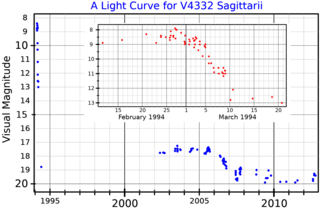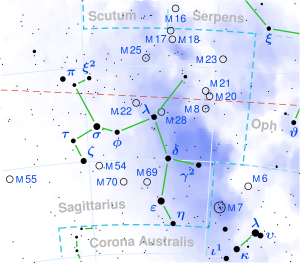
W Sagittarii is a multiple star system star in the constellation Sagittarius, and a Cepheid variable star.

Upsilon Sagittarii is a spectroscopic binary star system in the constellation Sagittarius. Upsilon Sagittarii is the prototypical hydrogen-deficient binary (HdB), and one of only four such systems known. The unusual spectrum of hydrogen-deficient binaries has made stellar classification of Upsilon Sagittarii difficult.

X Sagittarii is a variable star and candidate binary star system in the southern constellation of Sagittarius, near the western constellation boundary with Ophiuchus. It has a yellow-white hue and is visible to the naked eye with an apparent visual magnitude that fluctuates around 4.54. The star is located at a distance of approximately 950 light years from the Sun based on parallax, and is drifting closer with a radial velocity of −10 km/s. The star has an absolute magnitude of around −2.85.

NGC 6530 is a young open cluster of stars in the southern constellation of Sagittarius, located some 4,300 light years from the Sun. It exists within the H II region known as the Lagoon Nebula, or Messier 8, and spans an angular diameter of 14.0′. The nebulosity was first discovered by G. B. Hodierna prior to 1654, then re-discovered by J. Flamsteed circa 1680. It was P. Loys who classified it as a cluster in 1746, as he could only resolve stars. The following year, G. Le Gentil determined it was both a nebula and a cluster.

R136b is a blue supergiant star in the R136 cluster in the Large Magellanic Cloud. It is one of the most massive and most luminous stars known. It is found in the dense R136 open cluster at the centre of NGC 2070 in the Tarantula Nebula.

HD 93250 is a highly luminous hot blue binary star in the Carina Nebula in the constellation Carina.

HD 150136 is a multiple star system in the southern constellation of Ara, around 4,300 light years away. It is the brightest member of the faint open cluster NGC 6193, part of the Ara OB1 association.

VX Sagittarii is an asymptotic giant branch star located more than 1.5 kiloparsec away from the Sun in the constellation of Sagittarius. It is a pulsating variable star with an unusually large magnitude range. It is one of the largest stars discovered, with a radius varying between 1,350 and 1,940 solar radii (940,000,000 and 1.35×109 km; 6.3 and 9.0 au). It is the most luminous known AGB star, at bolometric magnitude –8.6, which is brighter than the theoretical limit at –8.0.

V4381 Sagittarii is a variable star in the constellation Sagittarius. A white supergiant of spectral type A2/A3Iab, it is an Alpha Cygni variable that varies between apparent photographic magnitudes 6.57 and 6.62. Its visual apparent magnitude is about 6.54.

7 Sagittarii is a massive star in the southern zodiac constellation of Sagittarius which is located in the Lagoon Nebula, although multiple sources have considered it a foreground star. It is a dim star but visible to the naked eye with an apparent visual magnitude of 5.37. The distance to this star can be determined from the annual parallax shift of 3.02±0.28 mas, yielding a value of roughly 1,100 light years. It is moving closer to the Sun with a heliocentric radial velocity of −11 km/s.
15 Sagittarii is a blue-hued binary star system in the southern zodiac constellation of Sagittarius. The estimated distance based upon photometry is around 4,200 ly (1,300 pc). It is faintly visible to the naked eye with an apparent visual magnitude of 5.37. The system is moving closer to the Sun with a heliocentric radial velocity of around −6 km/s.

HD 168607 is a blue hypergiant and luminous blue variable (LBV) star located in the constellation of Sagittarius, easy to see with amateur telescopes. It forms a pair with HD 168625, also a blue hypergiant and possible luminous blue variable, that can be seen at the south-east of M17, the Omega Nebula.

V3903 Sagittarii is an eclipsing binary star system in the constellation Sagittiarus. It creates an H II region LBN 29 1,070 parsecs away from the Sun.
HD 93403 is a spectroscopic binary containing two highly luminous hot blue stars. It is 10,000 light years away in the Carina Nebula in the constellation Carina. It appears to have spectral type O5.5III, but this is composed of two spectra from a blue supergiant and blue main sequence star of spectral type O5.5I and O7V respectively. The two stars orbit every 15 days with a separation that varies from 93 R☉ to 149 R☉. The binary is shedding mass at the high rate of 0.0005 M☉ per year.

WR 102 is a Wolf–Rayet star in the constellation Sagittarius, an extremely rare star on the WO oxygen sequence. It is a luminous and very hot star, highly evolved and close to exploding as a supernova.

V4332 Sagittarii is a nova-like event in the constellation of Sagittarius. It was discovered February 24, 1994 at an apparent visual magnitude of 8.9 by Japanese amateur astronomer Minoru Yamamoto from Okazaki, Aichi, then confirmed by K. Hirosawa. Initially designated Nova Sagittarii 1994 #1, it was given the variable star designation V4332 Sgr. A spectra of the event taken March 4 lacked the characteristic features of a classical nova, with the only emission lines being of the Balmer series. Subsequent spectra showed a rapid decline in luminosity and a change of spectral type over a period of five days. By 2003, the object was ~1500 times less luminous than at peak magnitude and showed a spectrum of an M-type star.

RS Sagittarii is an eclipsing binary star system in the southern constellation of Sagittarius, abbreviated RS Sgr. It is a double-lined spectroscopic binary with an orbital period of 2.416 days, indicating that the components are too close to each other to be individually resolved. The system has a combined apparent visual magnitude of 6.01, which is bright enough to be faintly visible to the naked eye. During the primary eclipse the brightness drops to magnitude 6.97, while the secondary eclipse is of magnitude 6.28. The distance to this system is approximately 1,420 light years based on parallax measurements.













